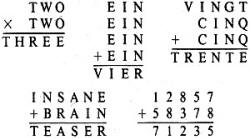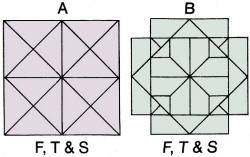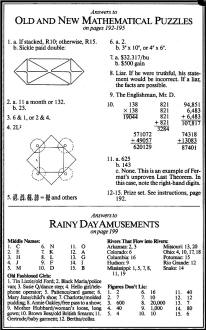Old and New Mathematical Puzzles
|
||
Here is another set of "Old and New Mathematical Puzzles," compliments of the 1985 edition of the Old Farmer's Almanac. All of the puzzles from Difficulty 1 through Difficulty 3 can be worked out without much trouble. Puzzle number 3 is a variation on an optical illusion based on the Möbius strip, or maybe more like a Klein bottle. Of course, being a farmer thing, there's a puzzle involving the number and price of produce at the market. There are four Difficulty 5 puzzles for which no solutions are given. They are the ones where readers are invited to submit solutions, and the winner for each receives a $50 award and honorable mention in the next year's edition. The winning solutions are never shown, but you can write to request a copy of them. It would be interesting to see what the solutions look like for this year's puzzle 13. You need to be good at three-dimensional drawing to render them. Old and New Mathematical PuzzlesBlanton C. Wiggin, Puzzle Editor From many puzzles submitted by readers we have selected 15 classical, original, or timely puzzles for 1985. They are graded for difficulty, so that there should be something of interest for everyone. We hope you find them challenging. No calculus, computers, or tricks. We try to include specialized knowledge, if needed, in the puzzle statement. We will award one prize of $50 for the best set of solutions to puzzles 12 through 15 received before February 1, 1985. The answers to these four are omitted here. These may sometimes require a chart or table of data from your local library. We use a point system to judge the prize set. A basic, unadorned, correct answer is 20 points. For a thorough analysis, an elegant or novel answer, up to 5 points extra. Numerical errors lose only 2 or 3 points, if it is clear that the method is understood. Explanations and Prize-Set Answers will be mailed after June 1 to anyone sending 50¢ and a self-addressed, stamped envelope to "Puzzle Answers," The Old Farmer's Almanac, Dublin, NH 03444. We'll also pay $15 for any original puzzles we use in The Old Farmer's Almanac for 1986. Closing date for submissions is March 1, 1985. Entries become the property of Yankee Publishing Incorporated and cannot be acknowledged or returned. In addition to submitting a puzzle, please tell us the type of puzzle you like best, such as magic squares, geometry, time-rate-quantity, mazes, logic, number substitutions, etc. From a group of good answers, we are happy to announce a first-time winner for 1984: Leon Kreidler, Sheboygan, Wis., with 88 points; followed by Walter Beveridge, Hartsdale, N.Y., 86; and past winner Newton Amos, St. Louis, Mo., 81. Other high scorers were Paul Nektaredes, Tarpon Springs, Fla., and Douglas J. Madea, Manheim, Pa. Please submit your favorite puzzles and send your answers early for puzzles 12-15. Use a separate sheet for each puzzle or answer, and be sure each sheet has your name and address on it. Good luck! Answers appear on page 200.
Difficulty: 1 a. Carpenter Hammer charged Farmer Sickle a capitalistic 5 rubles to saw a board into 2 pieces. At that rate, what should he charge to make 4 pieces? b. Sickle then challenged Hammer double or nothing to plow this pattern with one continuous line, never crossing itself. Did Sickle pay? Matt McCullar Fort Worth, Texas 2. Telling Time Difficulty: I a. In England and some other countries 9-2-85 usually means February 9. In the U.S., most people think of September 2. During a year, how many dates can be confused? b. During a single day, from one midnight to the next, how many times is the minute hand on a clock lined up with the hour hand? Paul R. Erickson Frankfort, Ill. 3. This and That Difficulty: 2 This and That are whole numbers. This and That, plus 1/2 of This, and That again = 11. How much is This and how much is That? Walter I. Christopher Carmichaels, Pa. Difficulty: 2 Mr. Jones owns a square pool with a tree at each corner. He has decided to enlarge the pool, but being a lover of nature, he wants to save his trees. The pool must maintain its original shape, and no tree is to be moved or cut down. Suppose a side of the original pool is L. What is the maximum area of the enlarged pool? Jose Diaz Boston, Mass. 5. Short-Cut Math Difficulty: 2 Quite obviously 26/65 = 2/5 by canceling the sixes! What other fractions with denominators less than 100 reduce correctly by incorrect means? Anita Burpee Goffstown, N.H. Difficulty: 3 a. If this three-dimensional object were constructed correctly, it would have four outside surfaces. However, someone goofed! How many outside surfaces does this "thing" have? b. If the object were a true conventional picture frame instead, 1" wide, what size picture, in whole inches on each side, would have an area equal to the face area of the frame? M.A. Frost Fort Worth, Texas 7. Peas, Beans & Barley
a. Mark, Joe, and John, all farmers, went to the market one day to sell their produce. They offered the following bushels: If the peas sell for $5 a bushel and beans for $4, how much would the barley price have to be for John to receive more money for all his produce than Joe and Mark put together? b. Feeling flush, John then bought some additional farm land for $10,000. Next day he felt differently and resold it for $10,200, but decided almost immediately that it was undervalued, He prevailed on his customer to sell back to him for $10,300 and sold it to someone else for $10,600 the third day. How much did John gain or lose? Eric Burgess Greenwood, Tenn. 8. The One That Got Away Difficulty: 3 We know that - Fishermen tell tall tales. - A flytier once said, "All flytiers are liars." - No flytier is both honest and a liar. Therefore, is the flytier a truth-teller feller or a tall-tale teller? Or are the facts contradictory? V. V. Lloyd Lynchburg, Va. 9. Espionage Express Difficulty: 4 Four spies in trench coats sat in two facing bench seats as they rode the Orient Express. Two sat next to the window and two next to the aisle. The English spy sat on Mr. B's left. Mr. A wore a tan-colored coat. The spy in olive was on the German spy's right. Mr. C was the only cigar-smoker. Mr. D was across from the American spy. The Russian was in khaki and the English spy stared out the window on his left. Who was the spy in the rust-colored coat? Paula Reiter Midwest City, Okla. Difficulty: 4 Can you substitute the same number for a letter each time the letter appears (or for a different digit in the last sum), for mathematically correct answers? Each problem is different, and there may be more than one answer to some. No left-hand zeros, please. 11. Endings Difficulty: 4 a. What are the last three digits of 19851985? b. What are the last three digits of 79999? c. For what n is this true? 1324n + 731n = 1961n? Gary Gettel Plano, Texas 12: Diagramless Cross-number Difficulty: 5 Across or Down - The year of-this OFA. - The sum of the six numbers in the puzzle is a perfect square. - No number in this puzzle begins with zero, of course. - Each of the ten digits is used only once in this puzzle. - Only one of the six numbers is composite. - Sorry you don't get a diagram or numbers, but if you make the first clue above go across, the solution is probably unique. Bob Lodge Seattle, Wash. Difficulty: 5 Here are 2 solid objects, a and b. The front, top, and side views of each are all the same. Can you draw a perspective or describe each? No wire, sheet metal, or surface designs. Some solid lines may hide dashed lines as is customary in mechanical drawing, but there are no unshown purely dashed lines. A. W. Mosenthal Corinth, Vermont 14. Big Number Difficulty: 5 What is special about: 8,589,869,056? David Edgar Hartford, Conn. 15. Curious Cubes Difficulty: 5 a. How many unique ways can you arrange 5 equal cubes so that at least one face of each cube fully touches another cube? Partial, edge, and corner touching don't qualify. Simple rotations are not unique; mirror arrangements that cannot be rotated are. b. If the cubes are dice, what is the maximum outside score that can be shown on an arrangement? c. What is the maximum number of equal cubes whose faces can simultaneously touch the faces of a single cube of the same size? Partial touching OK; edges and corners not. Fred Richardson Lincoln, Mass. ***
Answers
b. Sickle paid double: 2. a. 11 a month or 132. b.23. 3. 6 & 1, or 2 & 4. 4. 2L2 5. 19/95, 16/64, 49/98, 46/69 = 64/96 and others 6. a. 2. b. 3" X 10", or 4" x 6". 7. a. $32.317/bu b. $500 gain 8. Liar. If he were truthful, his statement would be incorrect. If a liar, the facts are possible. 9. The Englishman, Mr. D. 10. 11. a. 625 b. 143 c. None. This is an example of Fermat's unproven Last Theorem. In this case, note the right-hand digits. 12-15: Prize set. See instructions, page 192.
Posted February 27, 2024 |
||

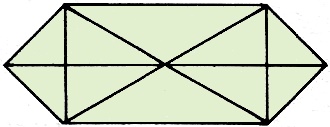 1. Russian Markets
1. Russian Markets 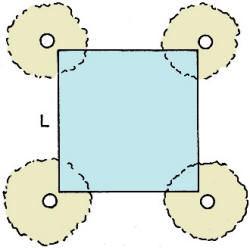
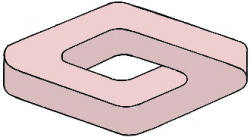
 Difficulty: 3
Difficulty: 3 